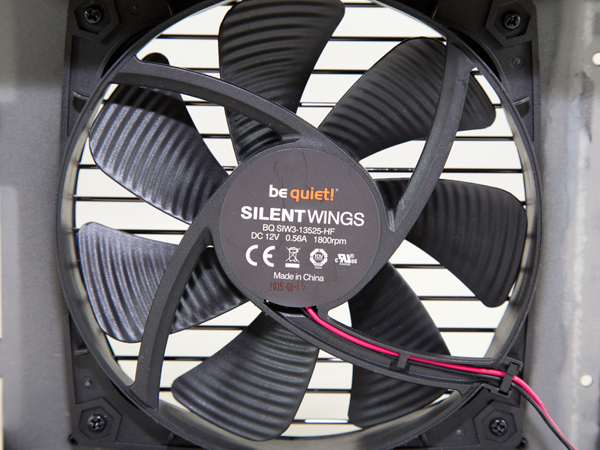Be Quiet! Dark Power Pro 11 1200W PSU Review
be quiet! says it's committed to building silent products, including the company's top PSU line, the Dark Power Pro 11. In this review, we will put the 1200 W Dark Power Pro 11 model to the test, which promises good performance and silent operation.
Why you can trust Tom's Hardware
A Look Inside And Component Analysis
Parts Description
Our main tools for disassembling PSUs are a Thermaltronics soldering and rework station and a Hakko 808 desoldering gun.
| Primary Side | |
|---|---|
| Transient Filter | 4x Y caps, 2x X caps, 2x CM chokes, 1x MOV |
| Inrush Protection | NTC Thermistor & Relay |
| Bridge Rectifier(s) | 2x Shindengen LL25XB60 (600V, 25A @ 113°C) |
| APFC MOSFETS | 3x STMicroelectronics STF31N65M5 (710V, 13.9A @ 100°C, 0.148 Ohm ) |
| APFC Boost Diode | 2x CREE C3D06060A (600V, 6A @ 154°C) |
| Hold-up Cap(s) | 2x Nippon Chemi-Con (420V, 470uF each or 940uF combined, 2000h @ 105°C, KMQ) |
| Main Switchers | 4x STMicroelectronics STF26NM60N (600V, 12.6A @ 100°C, 0.165 Ohm) |
| Driver ICs (Main Switchers) | 2x Silicon Labs Si8233BD-C-IS |
| APFC Controller | Infineon ICE2PCS02 |
| Switching Controller | Champion CM6901 |
| Topology | Primary side: Full-Bridge & LLC Resonant Converter Secondary side: Synchronous Rectification & DC-DC converters |
| Secondary Side | |
| +12V MOSFETS | 8x Infineon BSC014N04LS (40V, 100A @ 100°C, 1.4 mOhm) |
| 5V & 3.3V | DC-DC Converters: 2x Infineon MOSFETs PWM Controller: APW7159 |
| Filtering Capacitors | Electrolytics: Nippon Chemi-Con (105°C, KY, KZH), Rubycon (105°C, YXF) Polymers: Nippon Chemi-Con |
| Supervisor IC | SITI PS223S (OVP, UVP, OCP, SCP, OTP ) |
| Fan Model | be quiet! SilentWings 3, SIW3-13525-HF (135mm, 12V, 0.56A, 84.60 CFM, 1800 RPM) |
| 5VSB Circuit | |
| Rectifier | 1x International Rectifier RFR1018E (60V, 56A @ 100 °C, 8.4 mOhm) |
| Standby PWM Controller | Power Integrations TNY279PN |
| -12V Circuit | |
| PWM Controller | APW7174 |
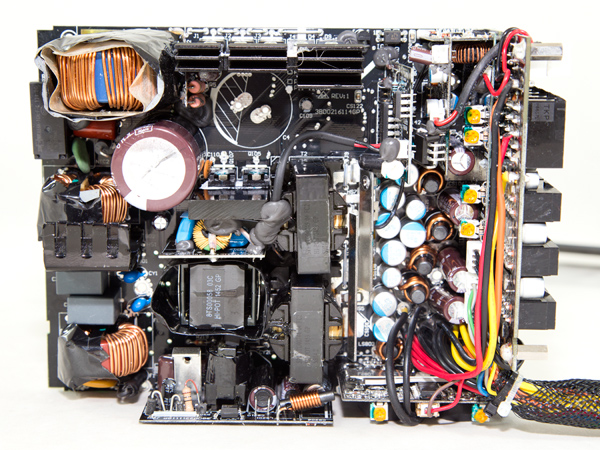
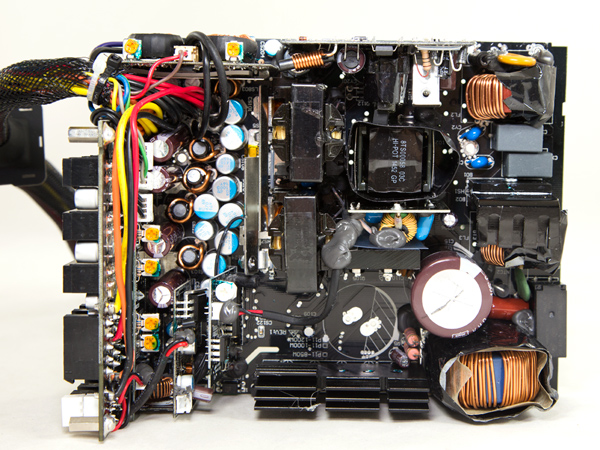
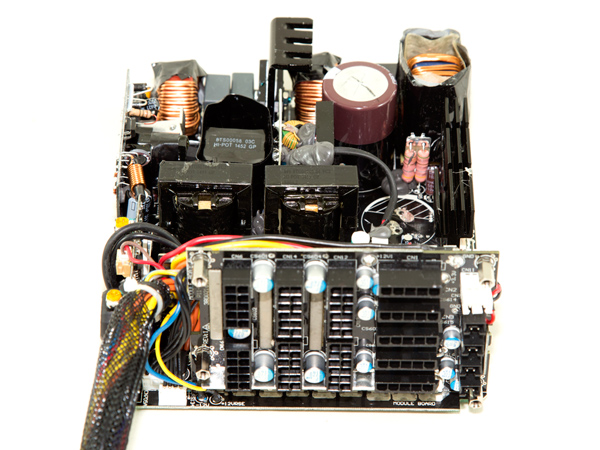

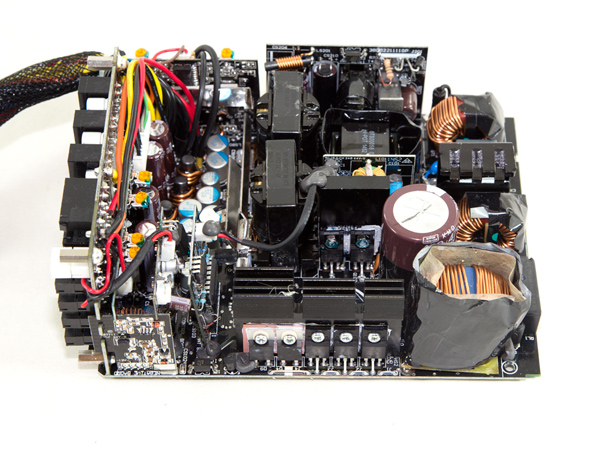
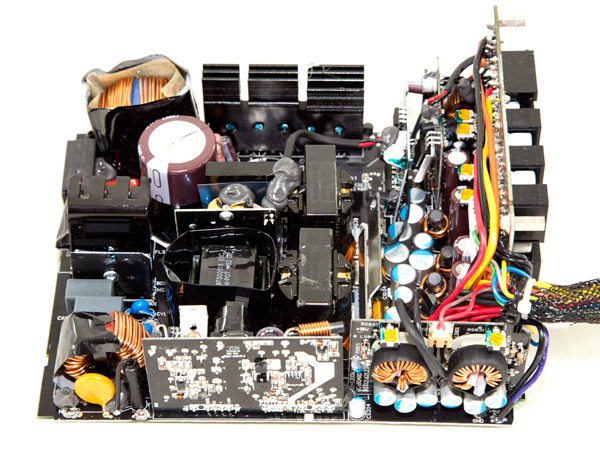
Dismantling this PSU wasn't easy. Lots of screws had to be removed and we had to be extra careful not to break any of the clips of the rear plastic cover on the modular panel. In the primary side be quiet! used a full-bridge topology along with an LLC resonant converter, while in the secondary side a synchronous design was used, along with a couple of DC-DC converters that generate the minor rails. All components are of high quality, with the capacitors provided by Japanese manufacturers, so we expect them to be highly reliable.
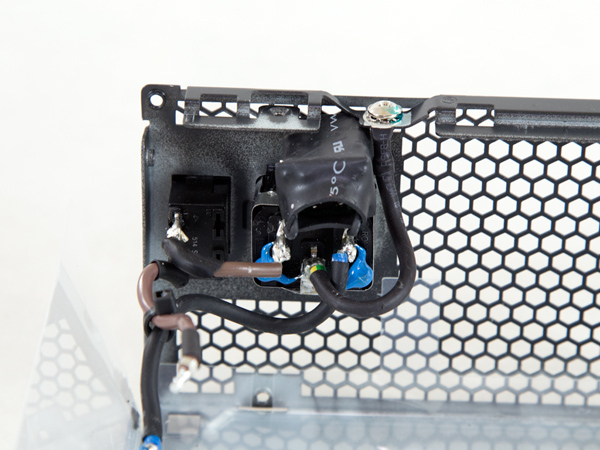

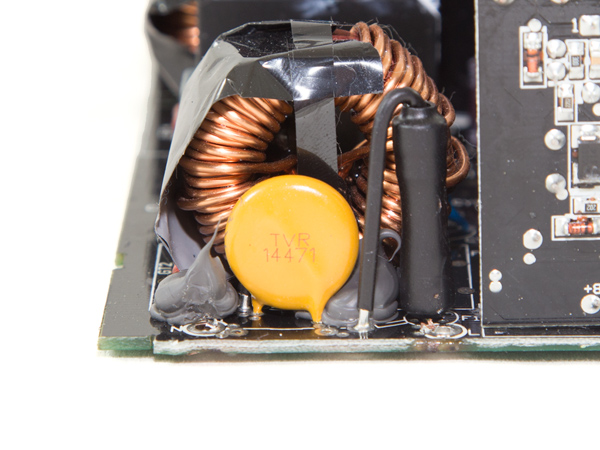
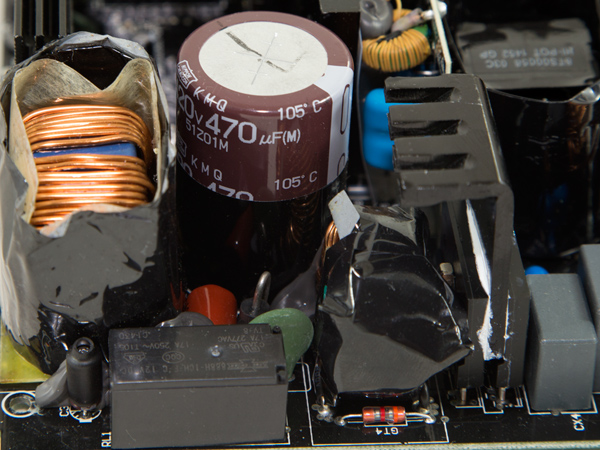
The first part of the EMI filter starts at the AC receptacle and includes a couple of Y capacitors. It continues on the main PCB with two more Y caps, two X caps, two CM chokes and an MOV. Finally, there is an NTC thermistor for protection against large inrush currents and an electromagnetic relay that allows for a fast cool-down.

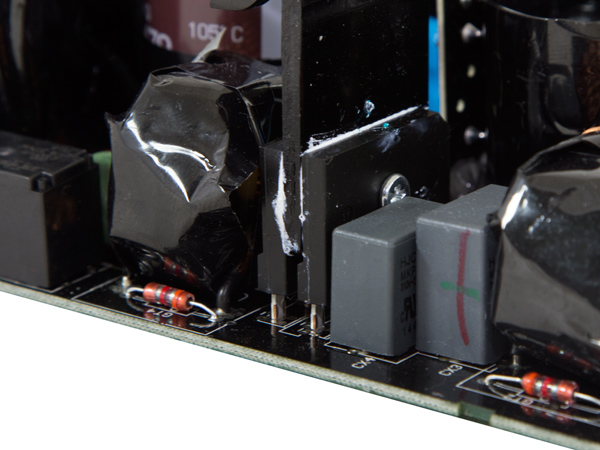
The two bridge rectifiers are provided by Shindengen (model number LL25XB60). Combined, they can handle up to 50 A of current, so they will easily meet the demands of this PSU.
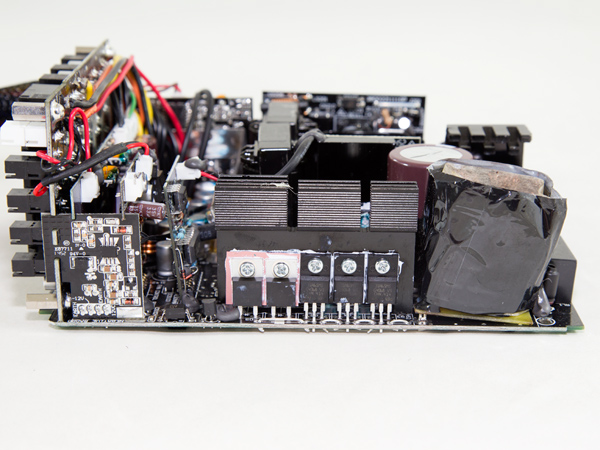
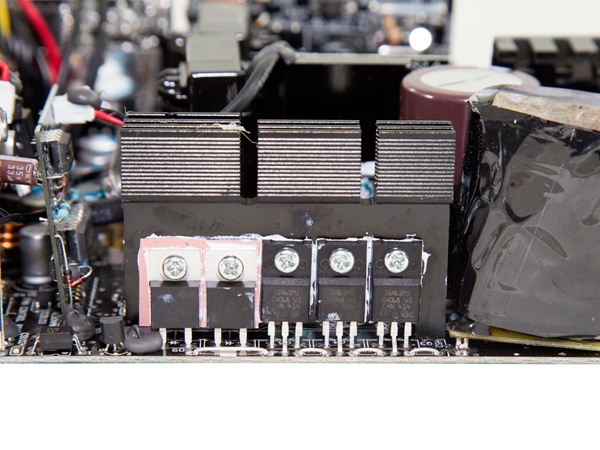
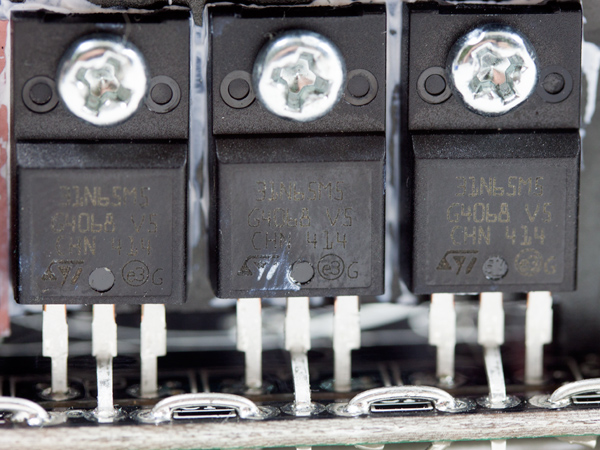
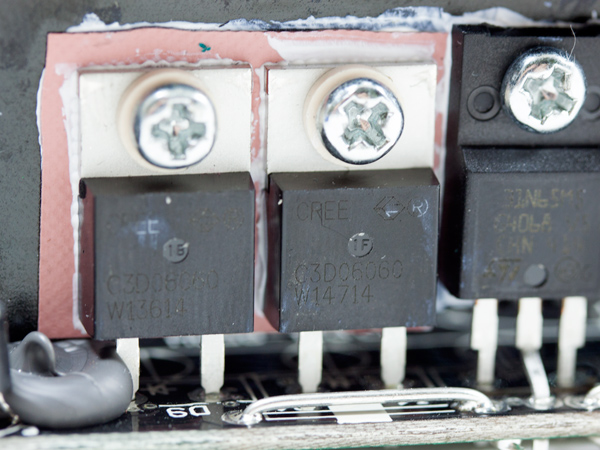

In the APFC converter we found three STMicroelectronics STF31N65M5 FETs along with a pair of CREE C3D06060A boost diodes. The bulk caps are from Nippon Chemi-Con (420V, 470uF each or 940uF each; 2000h at 105 degrees Celsius, KMQ series) and their capacity looks low for more than 16 ms of hold-up time.

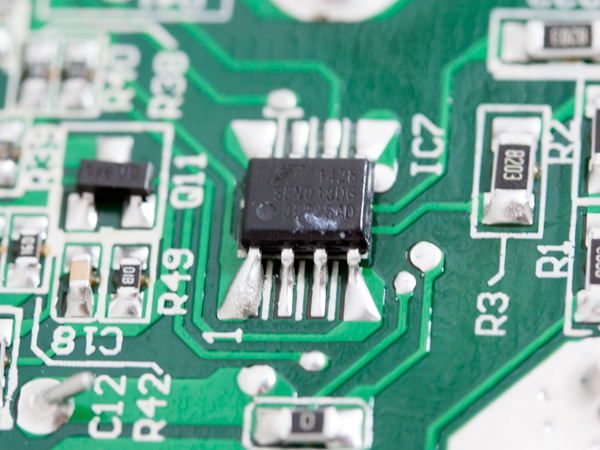
The APFC controller is an Infineon ICE2PCS02 IC, which is installed on the solder side of the main PCB. In the photo above, the ICE2PCS02 is in the middle, while the top IC is a SEN013DG, which is described as a "Zero Loss High Voltage Sense Signal Disconnect IC." Briefly, the SEN013DG disconnects the APFC converter while the PSU is in standby mode, in order to allow for the lowest possible energy consumption in this mode. Finally, the IC located in the bottom-left corner is an LM393, dual voltage comparator.
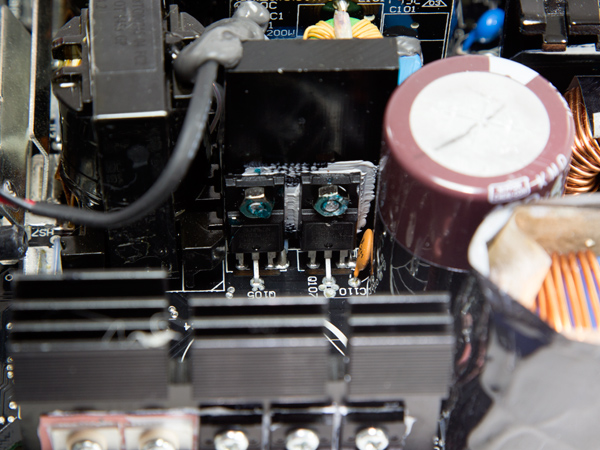
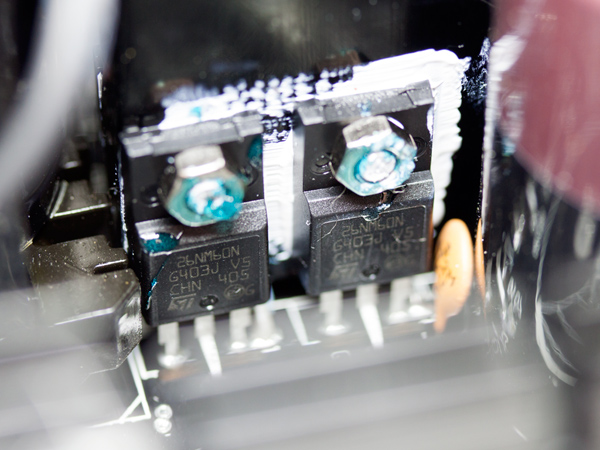
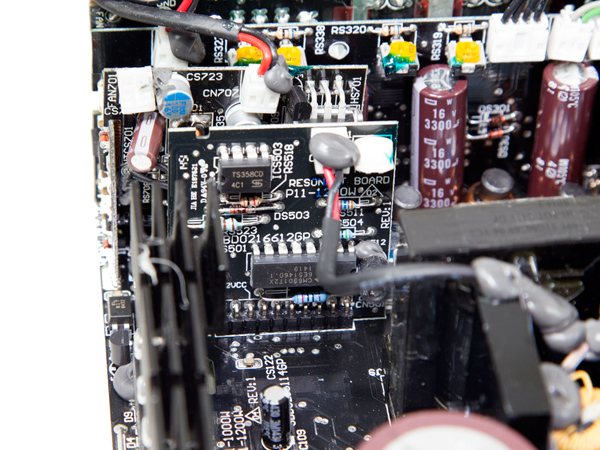

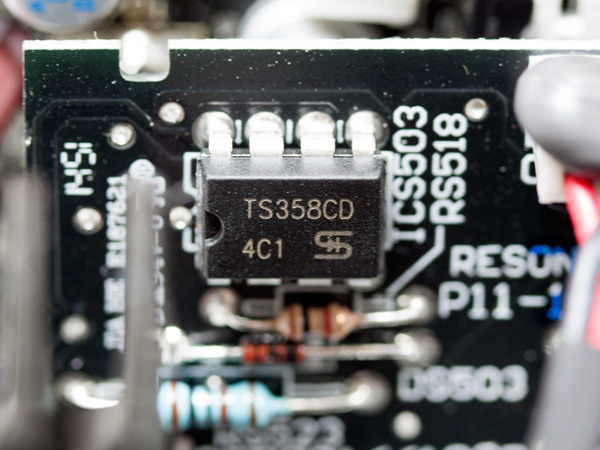
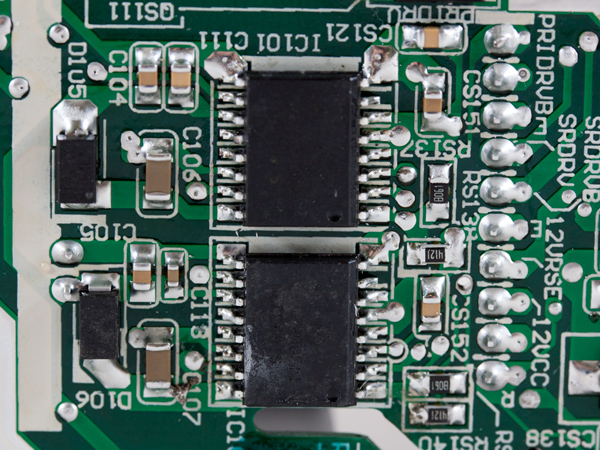
The main switchers, four STMicroelectronics STP22NM60N, are arranged into a full-bridge topology and the switching controller is a Champion CM6901. On the same board as the CM6901 is a TS358CD operational amplifier (op-amp). The driver ICs of the main switching FETs are two Silicon Labs Si8233BD-C-IS, which support switching frequencies of up to 8 MHz. Finally, an LLC resonant converter boosts efficiency by restricting switching-energy losses.
Get Tom's Hardware's best news and in-depth reviews, straight to your inbox.

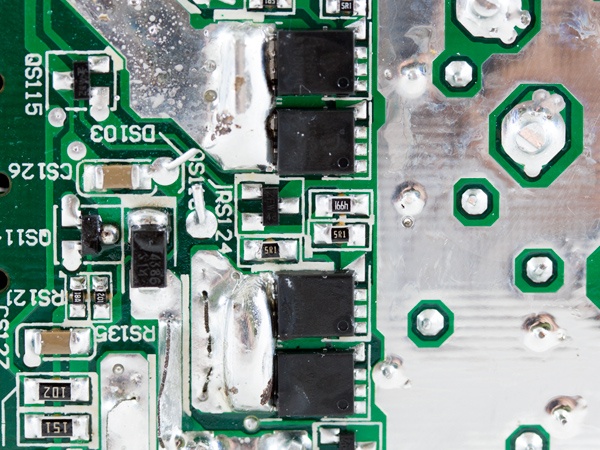
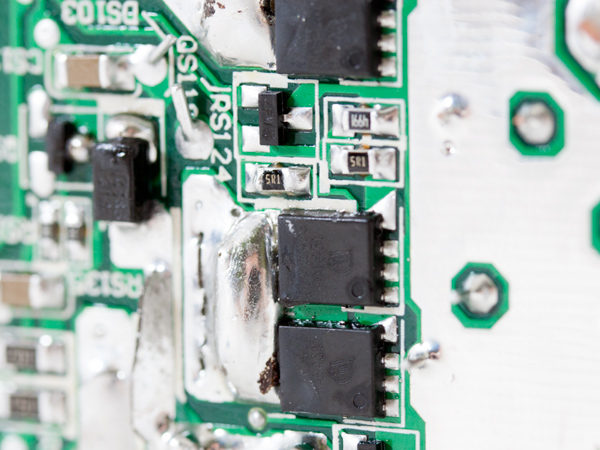
On the secondary side, eight Infineon BSC014N04LS FETs regulate the +12V rail. These are installed on the solder side of the main PCB. They are cooled down by the casing and two small heat sinks, which are installed on the component side of the PCB.

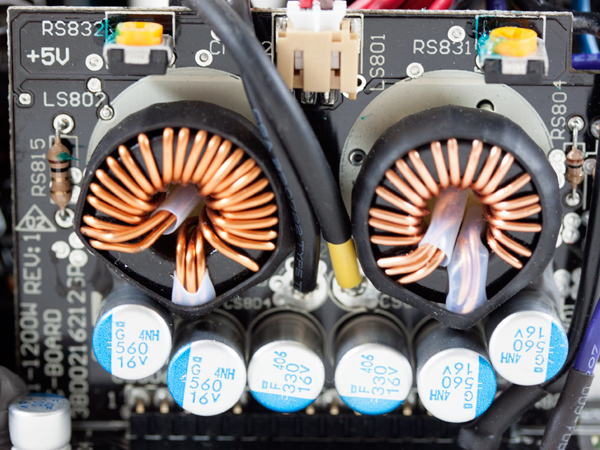

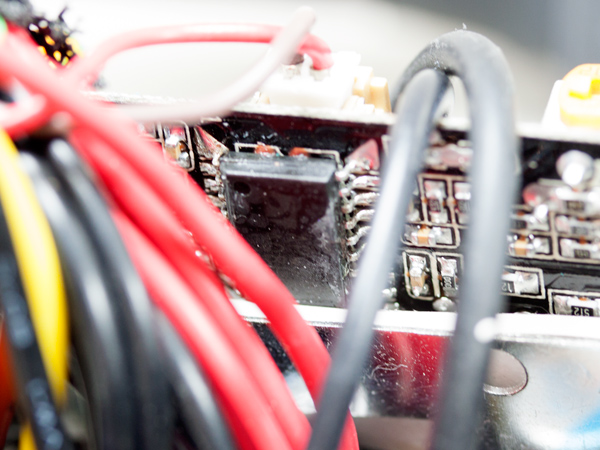
Both DC-DC converters that generate the minor rails are installed on a vertical PCB located on the secondary side. The common PWM controller of both VRMs is an Anpec APW7159.


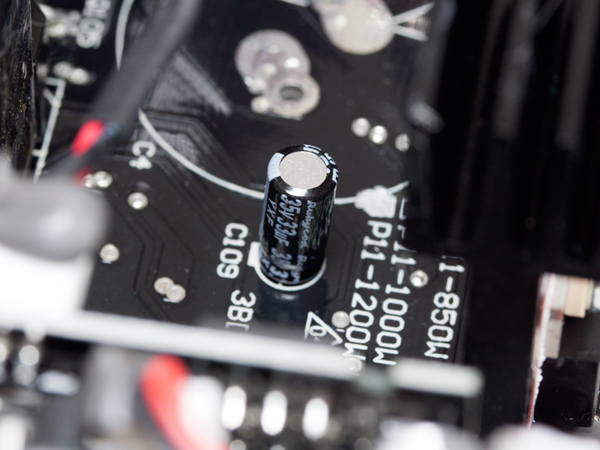
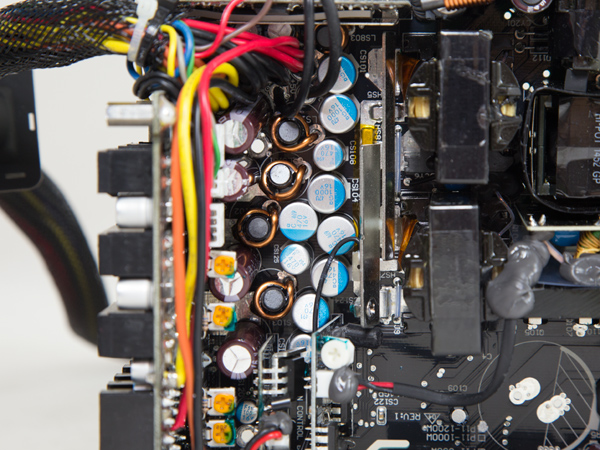
All electrolytic capacitors on the secondary side are rated at 105 C (221 degrees Fahrenheit) and most of them are made by Nippon Chemi-Con, while the rest are made by Rubycon. Finally, all polymer capacitors are made by Chemi-Con. This is an excellent choice of caps; we expected nothing less in a high-end PSU that costs almost $280.
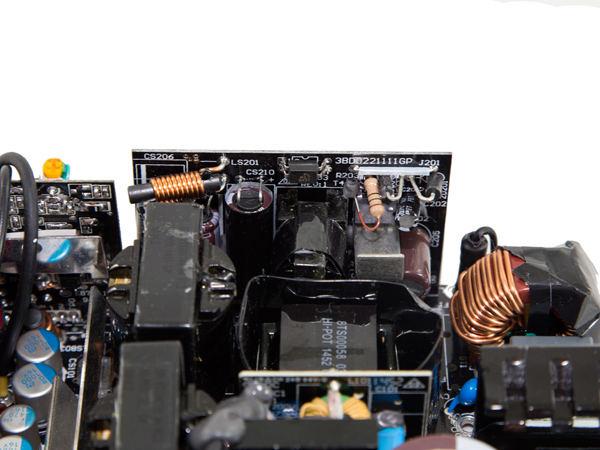
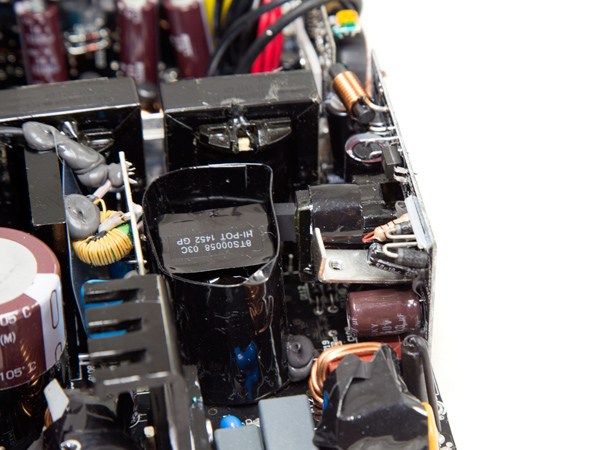
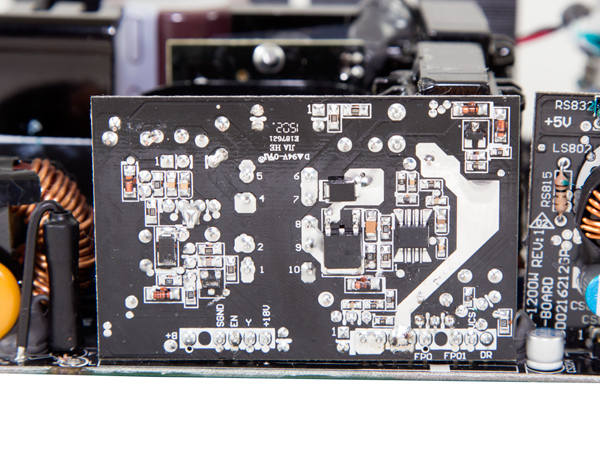
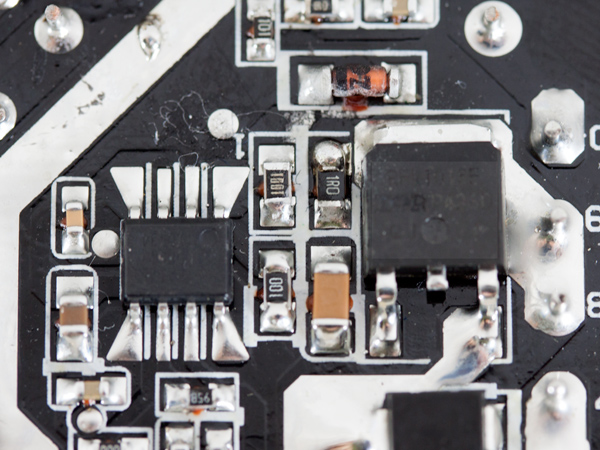
The circuit that handles the regulation of the 5VSB rail is located on a separate daughterboard, upon which we identified an International Rectifier RFR1018E FET and a Power Integrations TNY279PN standby PWM controller.

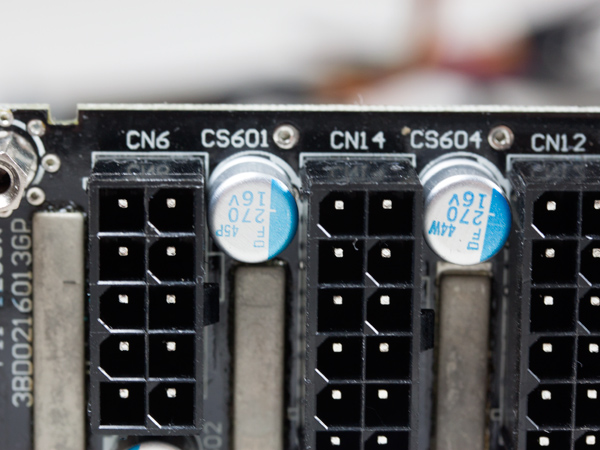
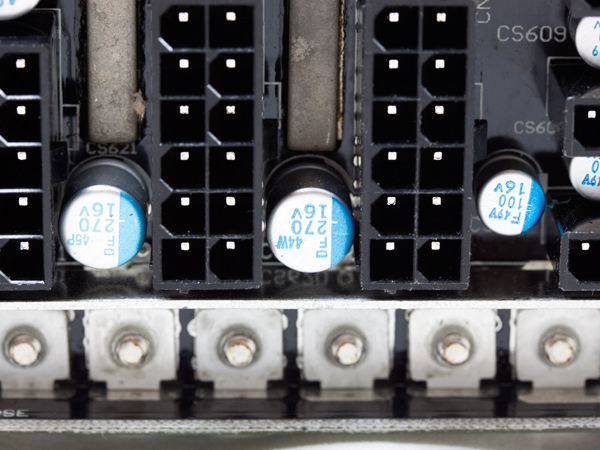
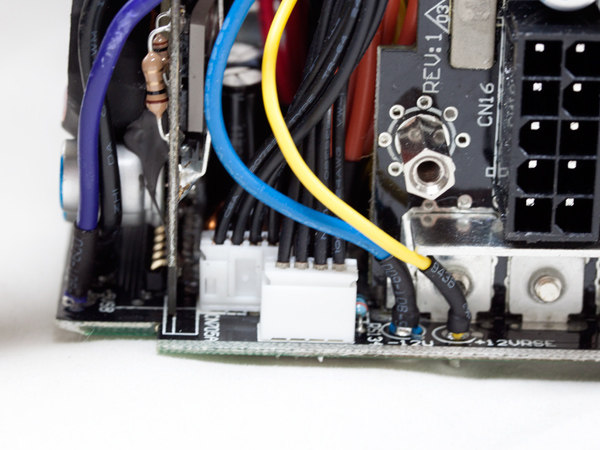

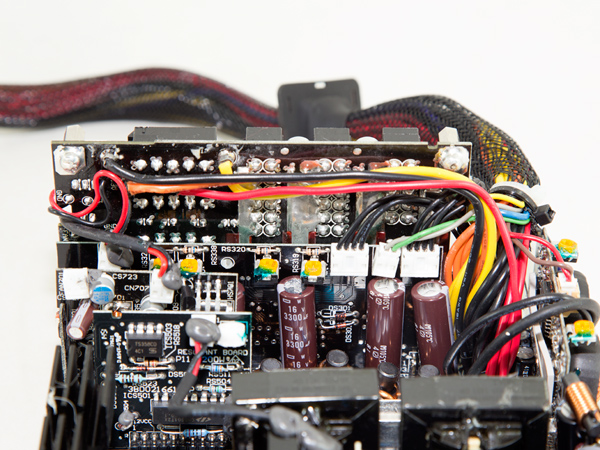
On the front side of the modular PCB, we found many filtering, polymer caps by Chemi-Con. On the back side of the same board, we would have liked a cleaner design.
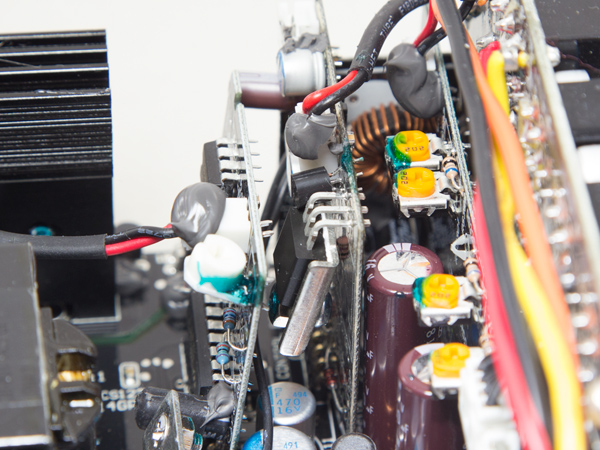
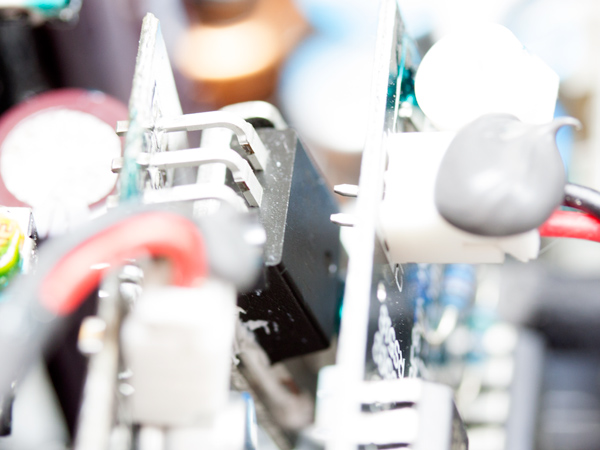
The PSU can control up to four external fans and this is accomplished with a separate sensor, which allows the fans to be electrically independent from the unit's internal fan.
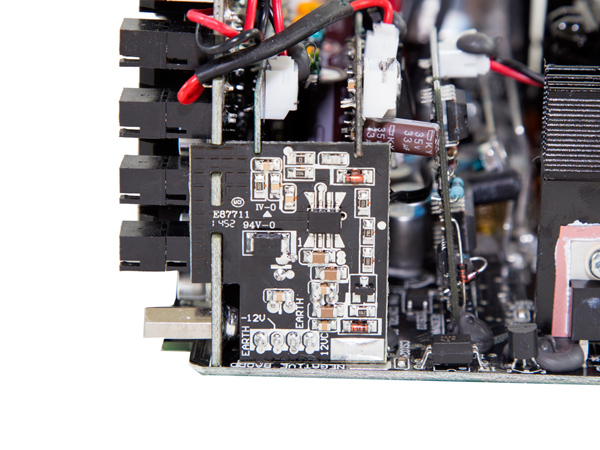
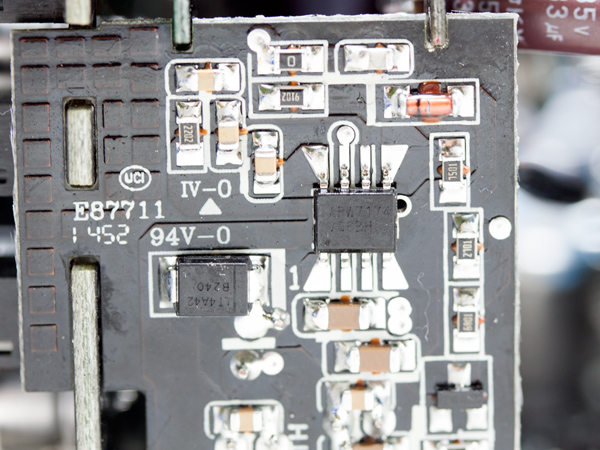
For the generation of the -12V rail, be quiet! used a dedicated circuit, which includes an APW7174 PWM controller. This is quite impressive since in most PSUs ─ even high-end ones ─ usually only a single diodehandles this task along with the suitable filtering components.
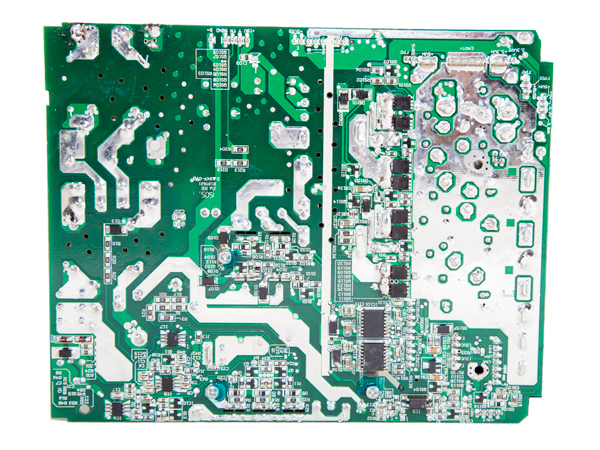
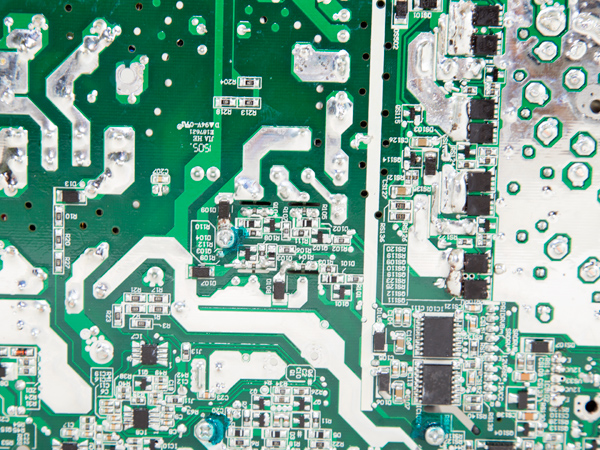
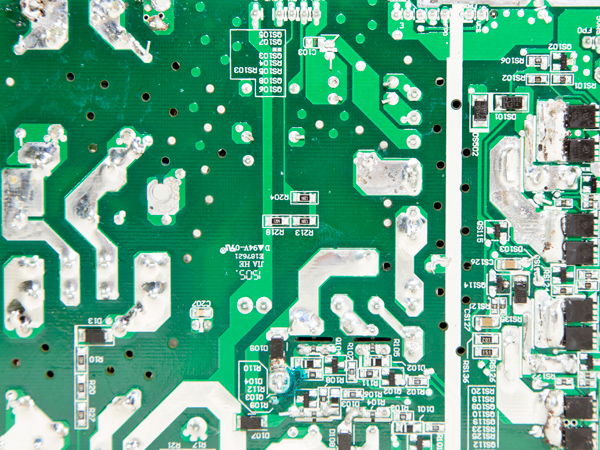

Like in the Dark Power P11-850 unit that we evaluated a while ago, soldering quality isn't among the best we have seen. We would like to see better soldering, and on the component side of the main PCB, some components aren't properly aligned in place, showing that FSP's production needs some improvements. We also found some component leads that were quite long, and in some cases were too close to each other.
The cooling fan carries be quiet!'s logo and belongs to the SilentWings 3 family. Its model number is SIW3-13525-HF (135mm, 12V, 0.56A, 84.60 CFM, 1800 RPM), and since it uses a fluid dynamic bearing it is going to last for quite a long time. Overall, it has a silent operation due to its pairing with a highly relaxed fan profile.
Current page: A Look Inside And Component Analysis
Prev Page Packaging, Contents, Exterior And Cabling Next Page Load Regulation, Hold-Up Time And Inrush Current
Aris Mpitziopoulos is a contributing editor at Tom's Hardware, covering PSUs.
-
Blueberries -12V Rail is very cool. These are really well built PSUs. I'd rather have a SeaSonic SS-1200 at this price range. I was expecting a better transient response change on the 5V rail, oh well.Reply -
chalabam Interesting, but way too much focus on PSUs over the kW, when the system builder marathons had peak overclocked power at 750w (and mostly 500w) for years now.Reply
And those computers spend most of the time running at 50/100 w, where even this unit efficiency is poor.
Good review, anyway, but I think that Tomshardware should focus on units that readers are more probable to buy. That info is more useful. -
chalabam Reply16727117 said:-12V Rail is very cool. These are really well built PSUs. I'd rather have a SeaSonic SS-1200 at this price range. I was expecting a better transient response change on the 5V rail, oh well.
Why you need 1200 W? What are you running? -
Blueberries Reply16727128 said:16727117 said:-12V Rail is very cool. These are really well built PSUs. I'd rather have a SeaSonic SS-1200 at this price range. I was expecting a better transient response change on the 5V rail, oh well.
Why you need 1200 W? What are you running?
Just because it's rated for 1200W doesn't mean you're drawing 1200W from the wall. The PSU in the article is a 1200W PSU so it makes sense to compare the two.
16727124 said:Interesting, but way too much focus on PSUs over the kW, when the system builder marathons had peak overclocked power at 750w (and mostly 500w) for years now.
And those computers spend most of the time running at 50/100 w, where even this unit efficiency is poor.
Good review, anyway, but I think that Tomshardware should focus on units that readers are more probable to buy. That info is more useful.
Power supplies are more efficient and put off less heat when they're not near their maximum load. If your system draws 500W you don't want to use a 550W PSU, you would be straining the PSU. SLI/CrossFire builds with multiple graphic processors can achieve a power draw of over 750W on the PCI Express rails alone!
I don't have a use for 1200W, but that wouldn't stop me from paying extra for better components, efficiency, and reduced noise. -
Aris_Mp indeed a PSU's peak efficiency is with typical loads (40-50% of its max rated capacity). However you should also take into account how long your system operates at full load. For example if your system is mostly working at idle or at low utilization then you will probably have more gain with a lower capacity PSU rather than with a high capacity one. On the other hand at high loads the stronger PSU will be closer to its sweet spot, having higher efficiency.Reply -
Blueberries Replyindeed a PSU's peak efficiency is with typical loads (40-50% of its max rated capacity). However you should also take into account how long your system operates at full load. For example if your system is mostly working at idle or at low utilization then you will probably have more gain with a lower capacity PSU rather than with a high capacity one. On the other hand at high loads the stronger PSU will be closer to its sweet spot, having higher efficiency.
It is absolutely true that power supplies are usually at their best efficiency around 50% of their maximum load, but that doesn't necessarily mean a smaller PSU is better. An AX1500 can peak at ~94% 12V efficiency, which is really good, but even at 300W it's still producing 91% efficiency, and over 90% at 150W. -
Blueberries Reply16732572 said:The AX1500i is a very special case :)
Be that as it may it's important to look at all of the factors. Amperage, Ripple, Efficiency, Hold-up, etc. Most important of all of course is build integrity and architecture. The best PSUs do have high loads, because well, they can handle it. They'll also last longer at any load.
An average load for an i7 user with a single high-powered video card is ~350W (gaming), a 980ti under maximum stress can be a 300-350W draw alone, bringing that up to a potential ~550W. In this scenario an RM750X is gold rated and will perform better than a Supernova P2 650W which is platinum rated. Both are extraordinary power supplies and I'd use either one. My point is, maximum load shouldn't matter. If a power supply meets more than your demands consider that a good thing. Most people aren't going to buy these PSUs unless they have a use for them because there's other options available.
The Dark Power Pro 11 in this article retains >90% efficiency from 200W-800W, which is a wide range, and your system load would want to fall between that range to be in the "sweet spot." A smaller PSU has a much smaller "sweet spot," but it could prove to be better. -
mctylr Replyindeed a PSU's peak efficiency is with typical loads (40-50% of its max rated capacity). However you should also take into account how long your system operates at full load.
It is absolutely true that power supplies are usually at their best efficiency around 50% of their maximum load, but that doesn't necessarily mean a smaller PSU is better.
All switching power supplies decrease their efficiencies as their load decreases, typically starting at or near 50% load and often rapidly decreasing efficiencies as their load falls below 20%.
For desktop systems, unless you run a distributed computation project in the background, 80-95% of the time the system is powered on, the system is idle or near-idle. In my limited testing a desktop system likely draws 50-100W at idle, so with a 1000W power supply it's operating at 5-10% load, and thus at its worst efficiencies.
With Haswell and newer consumer Intel's CPUs maxing out at 145W (I believe) at stock frequencies, and most video cards needing under 200-250 W maximum (980Ti 250W), a system with a single GPU rarely needs more then 600W.
Specifying the PS for 50% load (for maximum efficiency) to match the maximum load the system is actually capable of drawing is a poor efficiency trade-off, as the system will spend the majority of time time at under 20% utilization, at its worst efficiency, that the few percentage points of increased efficiency (at 50% load versus moderately higher loads) will result in a net lost.
Edited: Clarify first paragraph -
Blueberries Reply16734708 said:indeed a PSU's peak efficiency is with typical loads (40-50% of its max rated capacity). However you should also take into account how long your system operates at full load.
It is absolutely true that power supplies are usually at their best efficiency around 50% of their maximum load, but that doesn't necessarily mean a smaller PSU is better.
All switching power supplies decrease their efficiencies as their load decreases, typically starting at or near 50% load and often rapidly decreasing efficiencies as their load falls below 20%.
For desktop systems, unless you run a distributed computation project in the background, 80-95% of the time the system is powered on, the system is idle or near-idle. In my limited testing a desktop system likely draws 50-100W at idle, so with a 1000W power supply it's operating at 5-10% load, and thus at its worst efficiencies.
With Haswell and newer consumer Intel's CPUs maxing out at 145W (I believe) at stock frequencies, and most video cards needing under 200-250 W maximum (980Ti 250W), a system with a single GPU rarely needs more then 600W.
Specifying the PS for 50% load (for maximum efficiency) to match the maximum load the system is actually capable of drawing is a poor efficiency trade-off, as the system will spend the majority of time time at under 20% utilization, at its worst efficiency, that the few percentage points of increased efficiency (at 50% load versus moderately higher loads) will result in a net lost.
Edited: Clarify first paragraph
Yes but titanium efficiency PSUs retain 90% efficiency at a 10% load and platinum achieve at least 90% efficiency at 20% load. See: https://en.wikipedia.org/wiki/80_Plus
If the components are good they'll be able to handle a large load. There's no such thing as a good PSU that can't handle a large load. Most platinum PSUs can handle well over what they're rated for.
